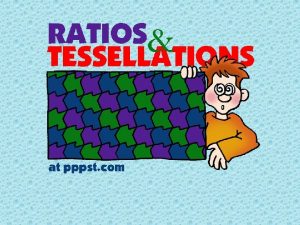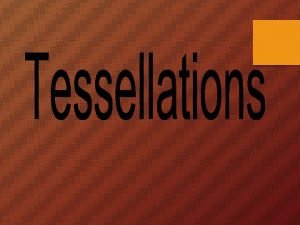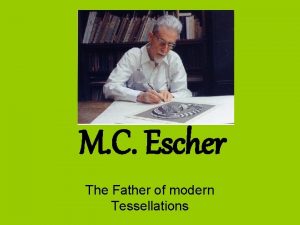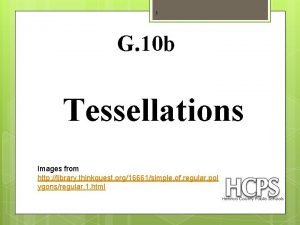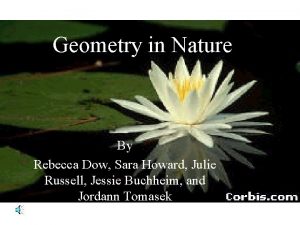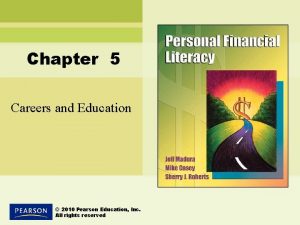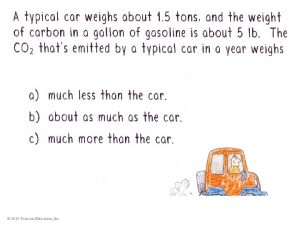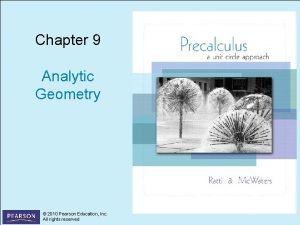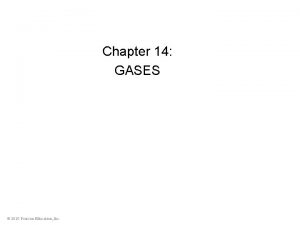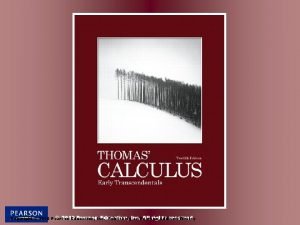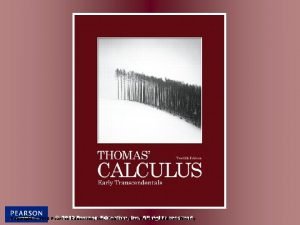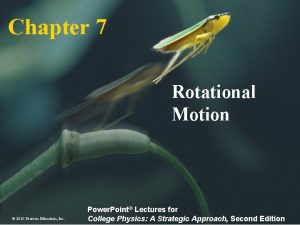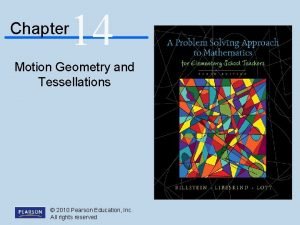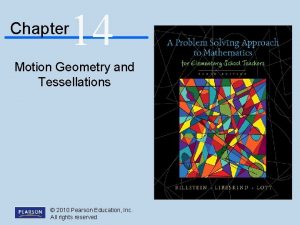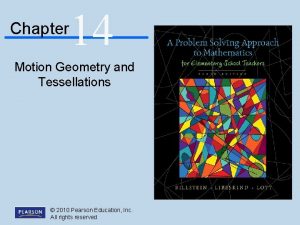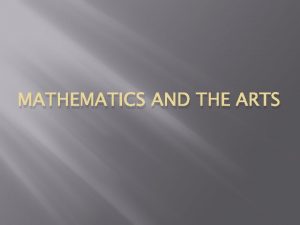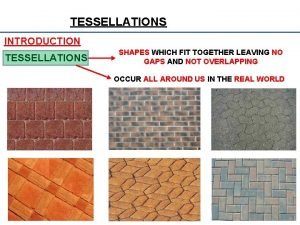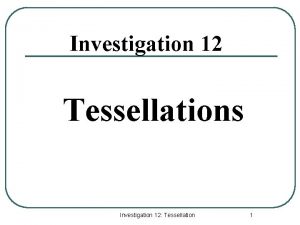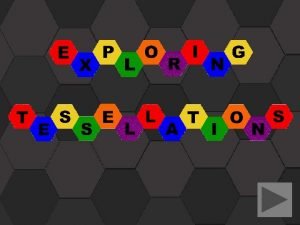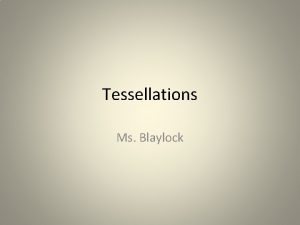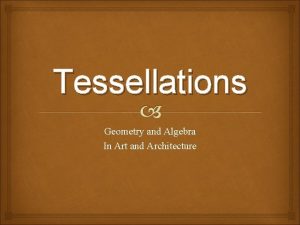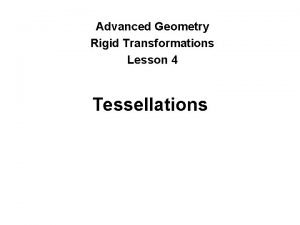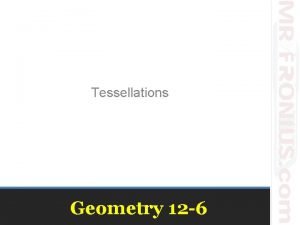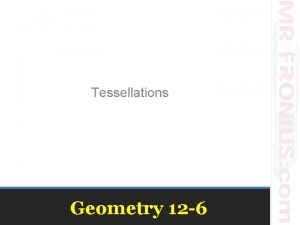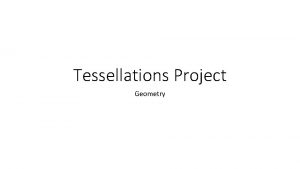Chapter 14 Motion Geometry and Tessellations 2010 Pearson

















- Slides: 17

Chapter 14 Motion Geometry and Tessellations © 2010 Pearson Education, Inc. All rights reserved

NCTM Standard: Motion Geometry Young children come to school with intuitions about how shapes can be moved. Students can explore motions such as slides, flips, and turns by using mirrors, paper folding, and tracing. Later, their knowledge about transformations should become more formal and systematic. In grades 3– 5 students can investigate the effects of transformations and begin to describe them in mathematical terms. Using dynamic geometry software, they can begin to learn the attributes needed to define a transformation. Copyright © 2010 Pearson Education, Inc. All rights reserved. 2

NCTM Standard: Motion Geometry In the middle grades, students should learn to understand what it means for a transformation to preserve distance, as translations, rotations, and reflections do. . At all grade levels, appropriate consideration of symmetry provides insights into mathematics and into art and aesthetics (p. 43). Copyright © 2010 Pearson Education, Inc. All rights reserved. 3

14 -2 Reflections and Glide Reflections § Constructing a Reflection by Using Tracing Paper § Constructing a Reflection on Dot Paper or a Geoboard § Reflections in a Coordinate System § Glide Reflections § Congruence via Isometries § Light Reflecting from a Surface Copyright © 2010 Pearson Addison-Wesley. All rights reserved. 4

Reflections Another isometry is a reflection, or flip. One example of a reflection often encountered in our daily lives is a mirror image. A reflection in a line ℓ is a transformation of a plane that pairs each point P of the plane with a point P′ in such a way that ℓ is the perpendicular bisector of PP′, as long as P is not on ℓ. If P is on ℓ, then P = P′. Copyright © 2010 Pearson Education, Inc. All rights reserved. 5

Reflections We can obtain reflections in a line in various ways. Folding the paper along the reflecting line and drawing the image gives the mirror image, of the half tree. Another way to simulate a reflection in a line involves using a Mira. Copyright © 2010 Pearson Education, Inc. All rights reserved. 6

Constructing a Reflection by Using Tracing Paper Trace the original figure, the reflecting line, and a point on the reflecting line, which we use as a reference point. Flip the tracing paper over to perform the reflection, and align the reflecting line and the reference point. Copyright © 2010 Pearson Education, Inc. All rights reserved. 7

Constructing a Reflection on Dot Paper or a Geoboard The image AB is reflected about line m. Copyright © 2010 Pearson Education, Inc. All rights reserved. 8

Example 14 -6 Find the image of ΔABC under a reflection in line m. Copyright © 2010 Pearson Education, Inc. All rights reserved. 9

Reflections in a Coordinate System For some reflecting lines, like the x-axis and y-axis and the line y = x, it is quite easy to find the coordinates of the image, given the coordinates of the point. Copyright © 2010 Pearson Education, Inc. All rights reserved. 10

Reflections in a Coordinate System The image of A(1, 4) is A′(4, 1). The image of B(− 3, 0) is B′ (0, − 3). Copyright © 2010 Pearson Education, Inc. All rights reserved. 11

Glide Reflections Another basic isometry, a glide reflection, is a transformation consisting of a translation followed by a reflection in a line parallel to the slide arrow. Original C 1 C 2 Translation image of C 1 m Reflection image of C 2 Glide reflection image of C 1 Copyright © 2010 Pearson Education, Inc. All rights reserved. C 3 12

Congruence via Isometries It is possible to define two figures as congruent if, and only if, one is an image of the other under an isometry or a composition of isometries. Copyright © 2010 Pearson Education, Inc. All rights reserved. 13

Example 14 -7 ABCD is a rectangle. Describe a sequence of isometries to show: a. ΔADC ΔCBA A half-turn of ΔADC with center E is one transformation. Copyright © 2010 Pearson Education, Inc. All rights reserved. 14

Example 14 -7 (continued) b. ΔADC ΔBCD A reflection in a line passing through E and parallel to AD is one transformation. c. ΔADC ΔDAB A reflection of ΔADC in a line passing through E and parallel to DC is one transformation. Copyright © 2010 Pearson Education, Inc. All rights reserved. 15

Light Reflecting from a Surface When a ray of light bounces off a mirror, the angle of incidence (the angle formed by the incoming rays and a line perpendicular to the mirror), is congruent to the angle of reflection (the angle between the reflected ray and the line perpendicular to the mirror). Copyright © 2010 Pearson Education, Inc. All rights reserved. 16

Light Reflecting from a Surface Copyright © 2010 Pearson Education, Inc. All rights reserved. 17
 Types of tessellations
Types of tessellations How to name a tessellation
How to name a tessellation Father of tessellation
Father of tessellation Escher ghosts
Escher ghosts Examples of tessellations in nature
Examples of tessellations in nature Lewis structure for pf3
Lewis structure for pf3 2010 pearson education inc
2010 pearson education inc Copyright 2010 pearson education inc
Copyright 2010 pearson education inc 2010 pearson education inc
2010 pearson education inc 2010 pearson education inc answers
2010 pearson education inc answers 2010 pearson education inc answers
2010 pearson education inc answers 2010 pearson education inc answers
2010 pearson education inc answers 2010 pearson education inc
2010 pearson education inc 2010 pearson education inc
2010 pearson education inc Copyright 2010 pearson education inc
Copyright 2010 pearson education inc 2010 pearson education inc
2010 pearson education inc Copyright 2010 pearson education inc
Copyright 2010 pearson education inc 2010 pearson education inc answers
2010 pearson education inc answers
